
|
This section explains the principle of impact moling and the installation procedure. Principle Impact moles consist of an enclosed steel tube containing an air-powered piston (also referred as the striker) that strikes the nose of the tool driving it forward. A bore is formed by displacing and compacting the soil laterally. The friction between the ground and the mole body prevents the mole from rebounding backwards. Repeated impacts of the piston … |
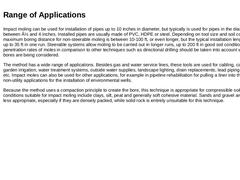
|
Impact moling can be used for installation of pipes up to 10 inches in diameter, but typically is used for pipes in the diameter range between ½ and 4 inches. Installed pipes are usually made of PVC, HDPE or steel. Depending on tool size and soil conditions, the maximum boring distance for non-steerable moling is between 10-100 ft, or even longer, but the typical installation length is usually up to 35 ft in one run. Steerable systems allow moling … |
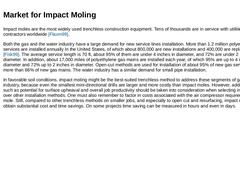
|
Impact moles are the most widely used trenchless construction equipment. Tens of thousands are in service with utilities and contractors worldwide [Flaxm99]. Both the gas and the water industry have a large demand for new service lines installation. More than 1.2 million polyethylene gas services are installed annually in the United States, of which about 800,000 are new installations and 400,000 are replacements [Fisk99]. The average service length … |

|
Impact moling is a trenchless installation method for placement of small diameter pipes, ducts and cables, in which percussion or hammering action of a pneumatic piercing tool is used to create the bore by compacting and displacing the soil rather than removing it. The method typically is non-steerable, although steerable systems have reached the market in recent years. When properly designed, impact moling is the simplest and the least expensive1… |
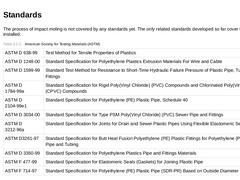
|
The process of impact moling is not covered by any standards yet. The only related standards developed
so far cover the pipes to be installed. (Table: American Society for Testing Materials (ASTM)) (Table: American National Standard Association (ANSI)/National Sanitation Foundation (NSF)) |
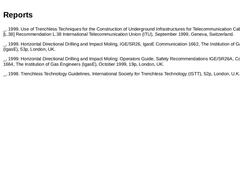
|
_, 1999. Use of Trenchless Techniques for the Construction of Underground Infrastructures for Telecommunication Cable Installation, [L.38] Recommendation L.38 International Telecommunication Union (ITU), September 1999, Geneva, Switzerland. _, 1999. Horizontal Directional Drilling and Impact Moling, IGE/SR26, IgasE Communication 1662, The Institution of Gas Engineers (IgasE), 53p, London, UK. _, 1999. Horizontal Directional Drilling and Impact Moling: … |

|
|
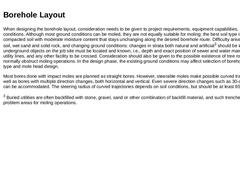
|
When designing the borehole layout, consideration needs to be given to project requirements, equipment capabilities, and ground conditions. Although most ground conditions can be moled, they are not equally suitable for moling: the best soil type is moderately compacted soil with moderate moisture content that stays unchanging along the desired borehole route. Difficulty arises with loose soil, wet sand and solid rock, and changing ground conditions: … |
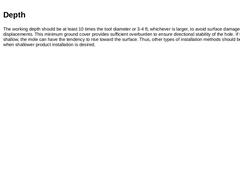
|
The working depth should be at least 10 times the tool diameter or 3-4 ft, whichever is larger, to avoid surface damage from soil displacements. This minimum ground cover provides sufficient overburden to ensure directional stability of the hole. If the hole is too shallow, the mole can have the tendency to rise toward the surface. Thus, other types of installation methods should be considered when shallower product installation is desired. |
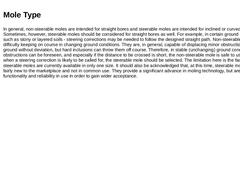
|
In general, non-steerable moles are intended for straight bores and steerable moles are intended for inclined or curved bores. Sometimes, however, steerable moles should be considered for straight bores as well. For example, in certain ground conditions ? such as stony or layered soils - steering corrections may be needed to follow the designed straight path. Non-steerable moles have difficulty keeping on course in changing ground conditions. They … |

|
Replaceable Heads Non-steerable moles can be provided with replaceable heads, which make them adaptable for different soil conditions. Several tool heads have been developed for different soil conditions to be used on moles with replaceable heads. Good selection of the tool head can improve the directional stability of the mole. Tapered heads are used in loose and wet soils when no buried obstacles are expected. Splined and stepped heads are better … |
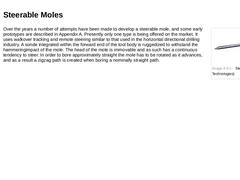
|
(Image: Steerable mole (TT Technologies)) Over the years a number of attempts have been made to develop a steerable mole, and some early prototypes are described in Appendix A. Presently only one type is being offered on the market. It uses walkover tracking and remote steering similar to that used in the horizontal directional drilling industry. A sonde integrated within the forward end of the tool body is ruggedized to withstand the hammeringimpact … |
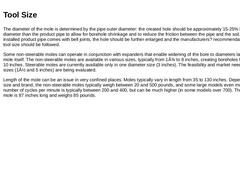
|
The diameter of the mole is determined by the pipe outer diameter: the created hole should be approximately 15-25% larger diameter than the product pipe to allow for borehole shrinkage and to reduce the friction between the pipe and the soil. If the installed product pipe comes with bell joints, the hole should be further enlarged and the manufacturers? recommendations for the tool size should be followed. Some non-steerable moles can operate in conjunction … |

|
Most impact moles operate from a standard air compressor and, for their optimal operation, a compressor of adequate capacity is required. The air consumption for impact moles depends on the size and type of the mole, but is typically in the range between 20 - 200 cfm. Operating pressure at the point where air hose is connected to the mole should not exceed the value recommended by the manufacturer and, as a rule of a thumb, there is a 2 psi drop … |

|
A protective sleeve is an auxiliary pipe, usually made of polyethylene (PE), which is attached to the rear of the mole and pulled in place while the borehole is being created. The product pipe is subsequently inserted into the sleeve, and the sleeve is then either left in the soil or pulled out of the ground. Most moling jobs are successfully completed without protective sleeves, but in some situations they should be considered. In unstable soils (… |

|
Any project performed in the proximity of another utility line or any other underground object carries a potential risk of damaging it. In impact moling, the biggest risk comes from possible deviation of the mole from the designed path. Another risk is the potential for possible damage caused by vibrations from the pneumatic hammering action. Some pipes, such as asbestos cement pipes, can be very sensitive to the sudden dynamic loading introduced … |
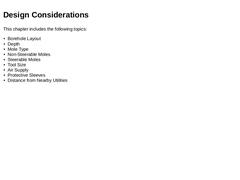
|
|
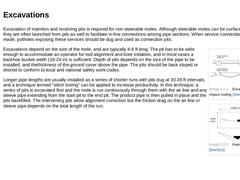
|
Excavation of insertion and receiving pits is required for non-steerable moles. Although steerable moles can be surface launched, they are often launched from pits as well to facilitate in-line connections among pipe sections. When service connections need to be made, potholes exposing these services should be dug and used as connection pits. |
(Image: Excavations in impact moling [Sterl01b])
|
|
(Image: Insertion pit [Sterl01b])
|
Excavations depend … |

|
Correct alignment of the tool in the insertion pit is extremely important for any impact moling project, but especially for non-steerable moling where bore accuracy cannot be achieved without the correct starting alignment. Specially designed aim and launch equipment can assure that the mole is aligned both vertically and horizontally before the boring starts. Such equipment includes an aiming frame, a surveyor's stake, a starting cradle and anchor … |
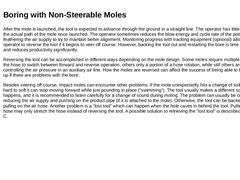
|
After the mole is launched, the tool is expected to advance through the ground in a straight line. The operator has little control over the actual path of the mole once launched. The operator sometimes reduces the blow energy and cycle rate of the piston by feathering the air supply to try to maintain better alignment. Monitoring progress with tracking equipment (optional) allows the operator to reverse the tool if it begins to veer off course. However, … |

|
Boring with steerable moles requires a two-person crew: the tracker operator and the mole operator. The information provided to them by the tracking system is the tool head position, depth, pitch, and roll. (Pitch is the inclination of the mole expressed in percentage of slope. Roll is the rotational position of the mole nose, commonly referred to as a "clock face". The 12-hour clock configuration is the basis for steering: up is 12 o-clock, down … |

|
Penetration rate of a mole depends on soil conditions and can vary considerably in just one crossing. Speed can affect the accuracy of boring if it is too high. The average penetration rate for non steerable moling is about 1-5 ft/min. The penetration rate may be further increased if the required bore accuracy is not high and can reach 8-10 ft/min or more in good soil conditions5. This usually involves use of some special attachments to the body … |
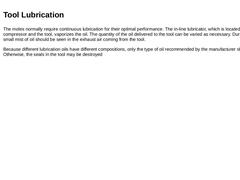
|
The moles normally require continuous lubrication for their optimal performance. The in-line lubricator, which is located between the compressor and the tool, vaporizes the oil. The quantity of the oil delivered to the tool can be varied as necessary. During boring, a small mist of oil should be seen in the exhaust air coming from the tool. Because different lubrication oils have different compositions, only the type of oil recommended by the manufacturer … |

|
The expansion of compressed air in the mole during the percussive action cools the tool. When the outside air temperature is low, the tool can be cooled so much that the water from the air can form an ice coating on the mole. The ice coating can stop the mole even at its full impact power. To avoid this problem, the compressed air should be heated before entering the mole and special compressed air heater is used for this purpose. Also, special lubrication … |

|
Usually the product pipe is pulled into place after the borehole is completed, by attaching it to the air hose in the receiving pit. However, the pipe can also be pushed in place and special pipe driving heads or slipon adapters over the existing heads can be used to convert the impact mole into a pipe-driving tool. If the product pipe is pulled in place simultaneously as the hole is bored, special pulling accessories, selected according to the product … |